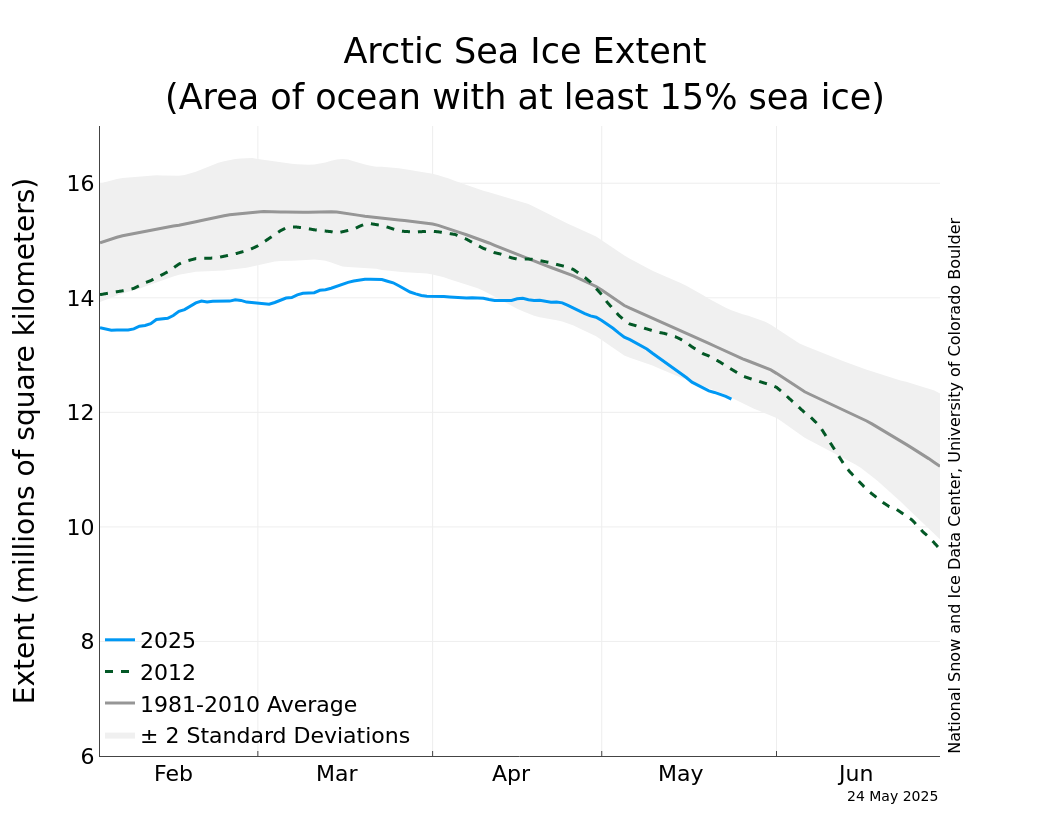Arctic sea ice continued its seasonal shrink during April, but not at the same starting pace that produced records and near records since last summer, according to the latest update by the National Snow and Ice Data Center.
This hesitation in the spring meltdown appeared temporary, however, with warm temperatures jump-starting ice loss and ripping open polynas in just the past few weeks, the NSIDC reported.
Meanwhile, the long-term outlook for the fate of the summertime pack remained as grim as ever. A new Arctic Council report to be released to diplomats next week claims that ice has been declining much faster than previously thought and predicts global sea levels will rise by as much as five feet over the next 90 years.
"The warning of much higher seas comes as the world's nations remain bogged down in their two-decade-long talks on reducing emissions of carbon dioxide and other greenhouse gases blamed for global warming," reported The Associated Press this week, after obtaining a copy of the report's executive summary.
Indeed, the total volume of sea ice — not just the size of the area covered by sea ice — continues to plunge year after year and has never been lower, according the April 3 ice mass estimate posted by the Polar Science Center at the University of Washington.
It's all part of an inexorable 30 year trend in declining sea ice across the Arctic. The situation climaxes each year during the summer melt season when the accumulated loss eliminates habitat for polar bears, walruses and seals. This annual summer meltdown also triggers even more climate warming because the dark ocean surface absorbs more solar energy than reflective white floes.
Since March 7, when it nearly tied for the smallest winter maximum on the books, the Far North's frozen ocean has slowly peeled back to the fifth smallest extent seen at this time of year since satellite monitoring began in the 1970s, according to the new analysis by the NSIDC.
Ice extent shrank about 11,560 square miles per day over the month — about one third slower than usual. During April, ice covered about 5.46 million square miles. That's about 328,000 square miles below the average seen between 1979 and 2000 for this month — a loss of a frozen habitat as large as California, Oregon and Washington combined.
"?For most of April, nearly all of the eastern Arctic, north of Europe and Russia, remained warmer than average," the NSIDC explained. "In contrast, most of the western Arctic was cooler than normal, with temperatures 6 degrees Celsius (11 degrees Fahrenheit) cooler than average over Davis Strait and Baffin Bay."
Because the eastern Arctic posted warmer temperatures all winter, the ice probably didn't thicken as much as previous winters and could retreat very fast as summer comes on, the scientists said.
"Most of the ice loss during April was in the Kara Sea, north of Siberia, and the northern Baltic Sea in Europe," the NSIDC reported. "Ice also retreated rapidly in the western Bering Sea and the Sea of Okhotsk.
Towards the end of April, ice loss accelerated in the eastern Arctic as temperatures warmed there, leading to the formation of open water areas, or polynyas."
The prediction of sea level rise comes from a new report by the Arctic Monitoring and Assessment Program, the research section for the eight-nation Arctic Council. The details will be presented next week in Nuuk, Greenland, during the 7th "ministerial" meeting of the council's eight members, including an appearance by U.S. Secretary of State Hillary Clinton.
"The melting of Arctic glaciers and ice caps, including Greenland's massive ice sheet, is projected to help raise global sea levels by 35 to 63 inches (90 to 160 centimeters) by 2100, AMAP said, although it noted that estimate was highly uncertain," The AP said.
"Summer ice coverage has been at or near record lows every year since 2001, said AMAP, predicting the ocean will be almost ice-free in the summer in 30 to 40 years. Arctic temperatures in the past six years were the highest since measurements began in 1880, and 'feedback' mechanisms are believed to be speeding up warming in the far north."
